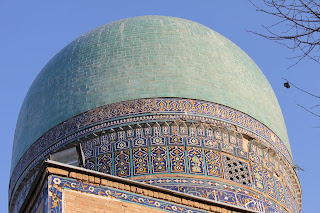We move to the Grand Samarkand Hotel. Our first stop is the
Bibi Khanum Mosque and mausoleum. Bibi Khanum was the Chinese wife of Amir
Timur, who built the mosque whilst her husband was travelling, to surprise him.
The architect of the mosque developed a soft spot for Bibi Khanum. He did not
live long… Legend has it that this was the start of women wearing veils in the Muslim world...
The Bibi Khanum Mosque is not as ‘polished’ as the Registan
complex we visited yesterday, but somehow more beautiful in its crumbling
splendour. Its main mosque has an impressive embellished interior and
mihrab (the praying niche facing Mecca) and looks onto an ample, tranquil
courtyard.
Time for exchanging money at the end of our visit. The
ticket seller’s husband is a money changer. She disappears with our $100 and
returns 15 minutes later with a bag full of notes, whilst Uzbek policemen look
on sat outside the gate.
We take some time out at a local Chai Khaneh, tea garden,
and try one of the local dumpling delicacies.
Samarkand’s old city has undergone a total facelift in the
last few years. It has been walled in and it has now become very difficult to
actually find an entry point into it. Following Lonely Planet’s clues we do…
The old city actually is now, even though quite haphazard in its layout, very
new. A large part of it had to be rebuilt following an earthquake. Abandoned
and decaying old buildings stand next to very modern abodes fronted by ugly
modern gates. We find ourselves standing in front of the synagogue, which is unfortunately
closed. Over 50,000 Jews, who had escaped from Persia in the 1400s, used to live
in what is now Uzbekistan, mainly in Samarkand and Bukhara. Most of them left
in the early 1990s and now live in Israel, Germany and Queens in New York. Only
a few hundred are left.
Next up is the local hommom (public baths). We are invited
to take a look by the local women, but in my polo neck (the day is quite
chilly) I look a little out of place in the steam bath… We are yet again positively
surprised by local friendliness and hospitality.
We quickly visit the Hazrat-Hizr Mosque for the beautiful
view of the city from its minaret and then walk through the Afrosiab (the name
of ancient Samarkand) cemetery before reaching the back entrance of the Shah-i-Zinda.
The site that has most struck me in my travels over the
years has to be the Masjid Lotfallah Mosque in Esfahan in Persia. Never have I
stood in a ‘temple’ for 45 minutes mesmerised by the beauty of my surroundings.
The Shahi-i-Zinda takes second place on the podium. You find yourself walking
down an ‘avenue’ of mausoleums, the buildings housing the remains of scholars
and royal family members, entranced in the complexity and beauty of the
patterns and colours both inside and outside. Fascinating… You turn the
corner into the next archway and you’re met by an even more impressive façade.
Take a look…
What a day! We head back for the same restaurant as the
previous evening. We liked it and the choice in Samarkand is somewhat limited…

























The Shah-i--Zinda is breathtakingly stunning. I have dreamt of going to Samarkand and Bukhara since I was a child. Your travel diary and photos have inspired me to make the journey in the not too distant future. Which did you prefer, Samarkand or Bukhara? Samia
ReplyDelete